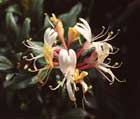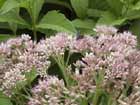Plant Profiles
Click on the first letter of the common name of the plant you wish more information about.
A | B | C | D | E | F | G | H | I | J | K | L | M | N | O | P | Q | R | S | T | U | V | W | X | Y | Z
J

Japanese Honeysuckle
Scientific Name: Lonicera japonica
Growth Habit: An evergreen vine with opposite rounded leaves up to 3 inches long, vining shoots are vigorous and grow to 12 feet long.
Light: Grows best in full sun but tolerates light shade.
Feedings: Apply a general garden fertilizer in March, June and September until established. Thereafter, feedings are seldom needed as plantings get nutrients from decomposing mulches and nearby feedings.
Water Needs: Tolerates short periods of drought; grows best with weekly waterings.
Ease of Culture: Easy.
Propagation: Cuttings or seeds.
Hardiness: Hardy; freeze-damaged leaves turn purplish but survive.
Major Problems: Not as vigorous in Florida as in Northern states; still fills an arbor or a fence.
Pruning: Keep shoots in bounds by pruning. Also, pinch out the tips of shoots to cause branching needed to fill trellises and fences. Direct the new shoots to areas on the supports that need foliage. Plantings may require major pruning to renew the vining shoots every five to eight years.
Uses: The Japanese honeysuckle is a familiar vine to relocated Northern gardeners. It can be used as a ground cover but is best trained to a trellis, a fence or an arbor. Flowers that form in pairs along the new shoots open white and fade to yellow. Blossoms, April through September, are fragrant and attract nectar-feeding insects.
Florida Native: No; native to eastern Asia.

Jasmine Nightshade
Scientific Name: Solanum jasminoides
Growth Habit: An evergreen vine with shiny 3-inch-long oval to lancelike leaves; grows to 20 feet long.
Light: Full sun to light shade.
Feedings: Apply a general garden fertilizer under the spread of the plantings monthly in March, June and September.
Water Needs: Tolerates short periods of drought; grows best with weekly waterings.
Ease of Culture: Easy.
Propagation: Start plants from cuttings.
Hardiness: Hardy; leaves and young stems may be damaged by severe cold, but they grow back from older shoots lower on the plants.
Major Problems: Plant in a nematode-free soil. Mites and scale insects can be a problem; control with soap or oil sprays as needed.
Pruning: Train to a trellis or an arbor. Tip back new shoots as needed to encourage branching. Overgrown plantings need periodic pruning to keep growth in bounds. Pruning is best performed after the plant has flowered during spring and summer.
Uses: Also known as potato vine; don't confuse the jasmine nightshade with the aerial potato vine in the yam family, an invasive weed in Florida. Quickly covers walls, fences or arbors with deep green leaves. Plantings produce star-shaped, blue-tinged white blossoms April through August. All plants in the Solanum genus are poisonous. Avoid planting in areas frequented by children.
Florida Native: No; native to Brazil.

Joe-pye Weed
Scientific Name: Eupatorium purpureum
Growth Habit: An evergreen perennial with multiple stems growing to 6 feet tall and half as wide. The leaves are bright green, lancelike and growing in whorls around the stem to 6 inches long and 2 inches wide.
Light: Plant in full-sun to lightly shaded locations.
Feedings: Apply a general garden fertilizer once monthly in March, June and August if needed for growth.
Water Needs: Keep the soil moist until the plants become rooted in the surrounding soil. Thereafter, water weekly during periods of hot, dry weather.
Ease of Culture: Easy; grows best in neutral to alkaline soils.
Propagation: Start plants from seed, cuttings or divisions of older plants.
Hardiness: Hardy.
Major Problems: Powdery mildew may affect plants during spring and fall; treat only as needed with a fungicide. Slugs and snails may feed on the foliage, chewing holes in the leaves. Use natural baits to control.
Pruning: Plants are rapid-growing and may need pruning during summer and early fall to remain in bounds. Give plantings a hard pruning during February to restrict growth and encourage flowering shoots.
Uses: A colorful plant for native and butterfly gardens. Also may be used as a backdrop for flower beds and along walkways. Pink, purple or cream-colored blossoms open in large clusters atop the foliage May through October. Plants attract many beneficial insects to the garden. Joe-pye weed also can be added to large container gardens.
Florida Native: Yes.

Johnny-jump-up
Scientific Name: Viola tricolor
Growth Habit: An annual flower with upright growth when young; develops a sprawling habit with age, growing to 8 inches tall and wide.
Light: Plant in full-sun to lightly shaded locations.
Feedings: Fertilize in-ground plantings lightly once a month with a general garden product; feed plants in containers every other week.
Water Needs: Prefers a moist soil; water when the surface begins to dry.
Ease of Culture: Easy.
Propagation: Start new plants from seed November through January.
Hardiness: Very hardy.
Major Problems: Make sure plants are set in the ground at the proper depth to avoid crown roots. Root balls should be set with the top at or slightly above the soil line. Plantings develop root rot in poorly drained soils.
Pruning: Remove early flowers as they begin to fade to encourage additional blooms. Trim plants that creep onto walkways.
Uses: Johnny-jump-up is a miniature version of its relative, the pansy, which is another popular winter flower. The blossoms are small and borne in profusion on stems rising above the foliage. Colors are usually blends of blue, purple, yellow and white. Cluster a number of plants in flower beds or use them to edge walkways. Johnny-jump-ups also can be added to hanging baskets and planter boxes.
Florida Native: No; native to Europe.

